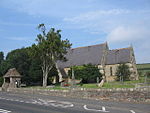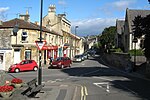Battle of Lansdowne
1643 in England17th century in SomersetBattles of the English Civil WarsConflicts in 1643History of Bath, Somerset ... and 2 more
Military history of SomersetRegistered historic battlefields in England

The First English Civil War battle of Lansdowne, or Lansdown, was fought on 5 July 1643, at Lansdowne Hill, near Bath, Somerset, England. Although the Royalists under Lord Hopton forced the Parliamentarians under Sir William Waller to retreat from their hilltop position, they suffered so many casualties themselves and were left so disordered and short of ammunition that an injured Hopton was forced to retire.
Excerpt from the Wikipedia article Battle of Lansdowne (License: CC BY-SA 3.0, Authors, Images).Battle of Lansdowne
Bath Road,
Geographical coordinates (GPS) Address Nearby Places Show on map
Geographical coordinates (GPS)
| Latitude | Longitude |
|---|---|
| N 51.4313 ° | E -2.401 ° |
Address
Sir Bevil Grenville
Bath Road
BA1 9DD
England, United Kingdom
Open on Google Maps










